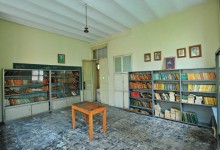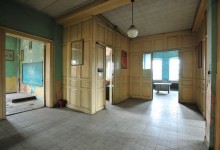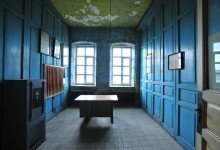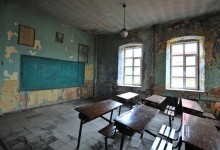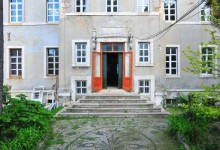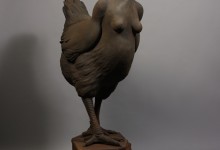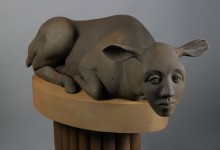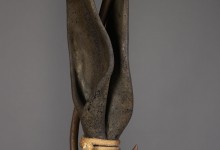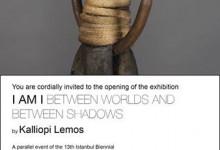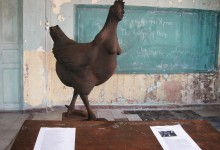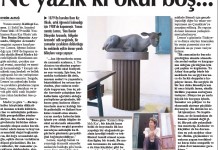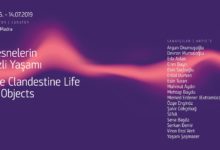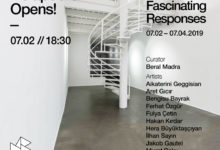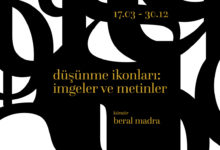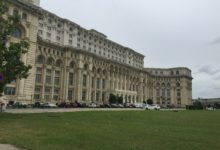Lemos_press_release_announcement_FINAL
BASIN BÜLTENİ
KALLIOPI LEMOS
“BEN BENİM, DÜNYALAR ARASINDA, GÖLGELER ARASINDA”
FFENER YOAKIMION RUM KIZ OKULU’NDA YERLEŞTİRME
11 EYLÜL-1O KASIM 2013
13. ISTANBUL BİENALİ PARALEL ETKİNLİĞİ
KÜRATÖR BERAL MADRA
11 Eylül’de Fener’de Yoakimion Rum Kız Okulunda (Kuruluş 1879) Kalliopi Lemos’un “BEN BENİM, DÜNYALAR ARASINDA, GÖLGELER ARASINDA” başlıklı sergisi, Beral Madra küratörlüğünde 13.İstanbul Bienali paralel etkinliği olarak açılıyor.
Lemos bu sergide yedi karışık teknikte heykelini ve bellek çağrışımlı bir ses yerleştirmesini sunuyor. Bu yapıtlar küresel bağlamda sürmekte olan ve özellikle Asya, Afrika ve AB arasında gerçekleşen yasa dışı göçlerin oluşturduğu trajik olaylarda en çok etkilenen kurbanlar olan kadınların ve çocukların durumuna dikkat çekmek amacını taşıyor.
Lemos’un projeleri 2006’dan günümüze, Elefsina (2006), İstanbul (2008) ve Berlin (Brandenburg Kapısı önü 2009)’de terk edilmiş teknelerle yaptığı yerleştirmeleriyle bu konuda geniş bir kamu bilinci oluşturmayı başardı. İstanbul için gerçekleştirdiği tekne yerleştirmesi Bilgi Üniversitesi Silahtarağa kampüsünde durmaktadır. 2012 yılında 3. Çanakkale Bienali için gerçekleştirdiği tekne yerleştirmesini ise Çanakkale’ye armağan etmiştir; bu yapıt Çanakkale Limanı’na yerleştirilecektir.
Lemos 1988’de öğrenci kalmadığı için kapatılmış olan YoakimionRum Kız Okulu için gerçekleştirdiği yerleştirmede kaçak insan trafiğinde kadın ve çocukların dillendirilemeyen deneyimlerine, gövdeleri ve onurlarına açılan derin yaralara odaklanıyor. O, her insanın hakkı olan “onur” ve saygınlık” gibi özelliklerin insan karakterinin temel nitelikleri olduğuna ve bütün zamanlar içinde kadınların ve çocukların toplumların duyarsızlığı nedeniyle çeşitli kötülüklere göğüs germek zorunda olduğuna inanıyor. Bu yerleştirme, bütün özellikleriyle kadın ve çocukların bu genel soruna nasıl dayanabildiklerini göstermek amacını taşıyor.
Sanatçı, bu sergisi için mitolojik figürleri çağrıştıran, kaideler üstünde duran, koltuk değneklerine dayanan ya da bir av ganimeti gibi tavandan asılan yarı insan yarı hayvan tunç heykeller üretti. Bu heykeller izleyicinin dikkatini insanın arkaik kültürlerine ve mitolojinin psikanalisttik perspektifine yönlendiriyor. Bu, farklı başlar ve gövdelerin birbirine eklenmesiyle oluşan melez karakterler adeta insan ve hayvan arasındaki doğal bağlantıların, iki doğa arasındaki eşiğin, eşikte duran varlıkların düşsel görüntüleridir. Bu karakterler, bir zamanlar çocukların doldurduğu, şimdi ise eşikte duran yüklü ve yaralı bilinçlerin metaforları olarak bu okulda yer almaktadır.
Sergi, FENER YOAKIMION RUM KIZ OKULU VAKFI’NIN izniyle, NİLÜFER SÜLÜNER koordinasyonunda ve endüstri tasarımcısı MURAT ÖZELMAS’ın mekan ve sergi tasarımında KUAD GALERİ, BM ÇAĞDAŞ SANAT MERKEZİ tarafından düzenlenmektedir.
Sergi 12 Eylül-10 Kasım arasında Pazar-Pazartesi dışında her gün 10.00-19.00 arasında gezilebilir.
Ayrıntılı Bilgi için:
İstanbul: Nilüfer Sülüner
sulunernilufer@gmail.com and info@kuadgallery.com
CATALOGUE TEXT
CURIOUS INTERSECTIONS OF BEINGS*
In the long ago abandoned building of the Greek Girls School in Fener (founded in 1879 as Ioakimion) the exhibition on the occasion of 13th İstanbul Biennale presents seven bronze sculptures, and a reminiscent sound installation by Kalliopi Lemos, all explicitly conceived for the ongoing global consideration on the status of women and children.
Lemos’s two seminal works are already in Turkey’s contemporary art agenda. Two boats, symbolizing the abandoned on Aegean islands, relics referring to the tragic end of illegal immigrants in their hopeless quest for a better life are installed in the park of İstanbul Bilgi University, Silahtarağa campus (since 2008). The boat covered with talismans made of pressed drink cans printed with embossed names of dead illegal immigrants, created for 3rd Çanakkale Biennale (2012) will be installed on the sea-side walk of Çanakkale harbor.
These previous works and the exhibition in İoakamion School mainly reflect Kalliopi Lemos’s persistent interest in the dignity and fate of destitute and power-stricken multitudes, victims of immeasurable neo-capitalism and irresponsibility of political powers. This is correspondingly one of the most projected concerns of UN Commission. The crucial knowledge that indicates the reasons of social and political crisis in patriarchal and male-controlled societies has been implemented by UN Commission on the Status of Women since Mexico (1975), Copenhagen (1980), Nairobi (1985) and Beijing (1995) conferences. The critical areas of concern such as Women and Poverty, Violence against Women, Women and Armed Conflict, Human Rights of Women, Women and the Media, Women and the Environment, The Girl-child were identified in the Beijing Platform for Action and still prevailing in its most severe forms.
Kalliopi Lemos’s work decisively intends to open a visual sphere of knowledge, perception and awareness into this reality.
In this current project, I Am I, Between Worlds and Between Shadows, Lemos consequently focuses on the experiences and the frequent abuse of the body and self-respect of these victims. She believes that human dignity is an inherent quality and an essential part of every human being that can never be separated from other characteristics of the person. Through time women have come to face and often accept behaviour of the social body that is insulting, wounding, suppressing and dominating and children have been exposed to a multitude of evil. Through this installation Lemos points to this inner core of humanity and the effort of women and children to uphold it.
For this purpose Lemos found Ioakimion School a metaphorically embracing space for her seven sculptures and a sound installation. The school, situated in one of the most historical districts of Istanbul, in the neighbourhood of the Ecumenical Patriarchate of Constantinople next to the impressive red brick building of Fener Greek Highschool. The rooms of the school are preserved as they were in 1988 when it was closed due to the absence of the Greek population in Turkey. The artists sensitively respected this cryptic resistance of memory through the school furniture and educational tools, books and official educational policy signs and visual materials. Indeed through this preserved environment a critical gaze can see the relational antagonism between the Nation State policy of the official education authority and the distinct identity of the Greek community.
The artist has created part-human, part-animal bronze sculptures, reminiscent of mythological figures, some on pedestals or crutches, and others hanging from the ceiling like a hunting trophy and diverts our attention to our common primeval origins. These are beings on a threshold, caught between two states or natures.
How should the viewer approach these mutant or hybrid figures, installed in the astoundingly well preserved environment of the schools rooms?
The paradigm change in the anthropocentric and humanistic discourse towards a post-humanistic and non-anthropocentrism has created its visual examples in contemporary art since three decades. (1) Like many artists of her generation Lemos employs this power of theriomorphism and creates these mutant or hybrid sculptures, which also correspond to her former characteristic mutant floral drawings and sculptures. These hybrid characters are imagined to be the natural copulation of human and animal bodies, heads and limbs.
Now as these metaphors of heterogeneous memories of liminal people have been created out of an imagination crossing the limits of customary representation and as they are seen in a building that is laden with limitless traumatic recollections, they reflect a transgressive approach as the only way of inciting awareness. With Foucault’s words this transgression contains nothing negative but affirms limited being-affirms the limitlessness into which it leaps as it opens this zone to existence for the first time. But consequently, this affirmation contains nothing positive: no content can bind it, since by definition no limit can possibly restrict it. (2)
Lemos had many possibilities to render her thoughts and convictions when she focused on the crucial local and universal theme related to the socio-political and economic oppression, discrimination, segregation of women and children. She prefers to enter into the realm of the relation between psychoanalysis, language and mythology. She is employing the affecting visual language of mythology and the hybridity with the intention to reach a psychoanalytical stimulus towards a mutual understanding of the viewer. Thus on one level this choice is based on the fact of Freud’s occupation with myths, when he “…gradually came to accept that at certain liminal points, the quest for knowledge could not but mitigate its demands, and that a self-conscious fiction, a myth, was sometimes as close as one could get to the truth.”(3)
In today’s conundrum of information flow and vast equivocalness, the truth, is the most difficult goal to reach, both for the artist and the viewer. Freud’s indication of using myths/mythology seems to be one of the possible ways to get near to it, even if Lacan
“does not expect any healing from the power of this truth” but advocates that “…the successive translation of the original problem into ever new metaphors, all equally problematic and imperfect, that repeat the original conflict in a slightly different configuration.” (4) might be the way of opening the discussion.
On the other hand this configuration of Lemos’s works is based on Nadia Sels interpretation of Lacan’s reflection on the inevitably “mythical” status of psychoanalysis itself:
“Both psychoanalysis and mythology explore the point where language, where thinking is founded (together with the subject). But in describing these foundations, they cannot but make use of the very instrument they are trying to describe. At this point, they cannot but be aware of the fact that the models they use are no more than tentative metaphors, “mythical” images. If psychoanalysis can be called a mythology, this does not have to mean that it is more mythical than any other discipline. What it does mean is that it operates at the point where every language is confronted with its own inevitably metaphorical character.” (5)
Lemos’s spectral humanoid creations are undoubtedly and firmly rooted in her perception of art-making as a continuous and interrelated process since the cave paintings. Greek Mythology and the imprint of Surrealism and its post-modern extensions are the two basic contextual paths she is following and her works have these psychoanalytical and surrealistic veins that are visualized in the animal imagery, myth and occult symbolism. Hybridization of natures might be an important topic in today’s science but hybridization of humans and animals has occurred in different traditional and modern cultures as early as Neolithic and in Modern art through Surrealism, as examplied in the works of Max Ernst and Leonora Carrington. One of most significant examples of Modernism is René Magritte’s “La Raison pure” (1948) which shows a melancholic looking horse-woman. This half-human half-animal head looking to the landscape-theather stage with leaf-trees and a horse rider is in a play of identity; in an identity tension, which has hardly a solution. The profound reasoning of Lemos’s work is precisely point to this still prevailing identity tension of humankind.
Her mutant or hybrid figures, which are somehow genetic manipulations, constitute a promising iconography of fantastic poesy or a visual linguistic experimentation, but also question the boundaries between the human and animal sphere. Her method of dealing on the sphere of interaction between human and animal is implicating that the modernist approach of dividing the world into anthropocentric-humanistic and non-human does not make much sense anymore.
However these hybrid figures have an additional reference. To create the metaphor of the unimaginable harassment and on extreme cases bloodshed inflicted on socially deserted women and children, she had to employ alienation, which is clearly a primary theme of her installation. The hybrid forms are in between being fearsome and charming and they demonstrate a peculiar distinctness, so that the alienated viewer is steered to sense and acknowledge the meaning of their otherness. This alienation even reveals the deep-rooted political and economic complexities on the people’s lives of our times by rendering the attitudes: Quiet animal-human hybrids that appear simultaneously as victims and assaulter.
Challenging the perception and power of imagination of today’s spectator who is under the spell of the current time virtual world icomania through a weird realm of imagination she deliberately introduces an archaic knowledge of form and aesthetics. Evidently with the conviction that “… in the human imaginary the animal may go back to be the alter ego, the prominent referent, the sacral figure able to projecting the human thoughts towards new experiences. (6)
She will be testing the functions of imagination of the viewer through the merge of humanness and animalness in reference to their traditional cultures. In this corpus of “anthropological image” some of the figures represent and reflect the image of women identity as a transgressive anthropological reality in conjunction to today’s complex and ambiguous status of women in the Globalized Christian and Muslim contexts.
The sound installation created by the artist seems to communicate this alienation. Even if these voices, sounds, noises, echoes are reminiscent of the past function of the building, it clashes with the existence of humanoids, and heightens the sense of what belongs and what doesn’t belong to.
In post-modern art the appearance of animals in art is debated to be the sign of a void, of non-self-sufficiency, of a need for a dialogue. Evidently Lemos’s art-making follows this path and this is the challenge that guides Lemos to create this group of hybrids. It is set by the post-humanistic discourse and emphasizes the appreciation of identity, marked by the indelible position of the “other” as a determining identity.
A mermaid coming out of a well, which also brings to mind a rostrum, greets the viewer at the central hall of the building. The rostrum as means of correct training (7) refers to the initial educational function of the school. It is a strict discipline system that creates Modern compatriots. The mermaids are the symbol of perilous events, of adventures, of the unknown and are believed to entice the people to a doom; however they can also be benevolent or beneficent, bestowing blessings to humankind. Along with the appreciation of identity of the “other” as a determining identity, this is another key metaphor of the whole installation: The eternal dilemma engendered between the order of things and the nature of humankind.
This mermaid seems to invite the viewer to visit each class-room where the hybrid sculptures are installed and the recent newspaper articles about the violence of women and children are put on the empty desks as if they are educational material. The whole work is accompanied by a sound documentation of voices and traditional songs of school girls. The viewer can explore the real story of children and women through metaphors, hybridization, ambivalence, polarity which according to Freud are qualities created by fear and the unresolved.
The exhibition undoubtedly aims to generate awareness among art professionals, open a public discussion by engaging the local and international community of Istanbul and promote public participation on the realities which are only revealed in short paragraphs and numbers in the press and media. Otherwise, the individual stories behind these paragraphs and numbers are not even a historical fact or common memory of the communities of these victims.
* Inspired from: Michel Foucault, “Preface to Transgression”, Language, Counter-Memory, Practice, Selected essays and Interviews, ed. By Donald F. Bouchard, Cornell Paperbacks, 1980, p.34
1.Karin Andersen and Luca Bochicchio the presence of animals in contemporary art as a sign of cultural change, forma. revista d’humanitats, issn 2013-7761, vol. 6, december 2012, k. andersen & l. bochicchio, pp. 12-23.12; fecha de recepción: 6/7/2012; fecha de aceptación: 23/11/2012, page 12
2.Michel Foucault, “Preface to Transgression”, Language, Counter-Memory, Practice, Selected essays and Interviews, ed. By Donald F. Bouchard, Cornell Paperbacks, 1980, p.35-36
3.Nadia Sels, Myth, Mind and Metaphor, On the Relation of Mythology and Psychoanalysis, 4 (2011): 56
4.Sels, S4 (2011): 67
5.Sels, S4 (2011) 68
6.Karin Andersen and Luca Bochicchio, p.21)
7.Michel Foucault, Discipline and Punish, Vintage Books, 1995, p. 170-194

